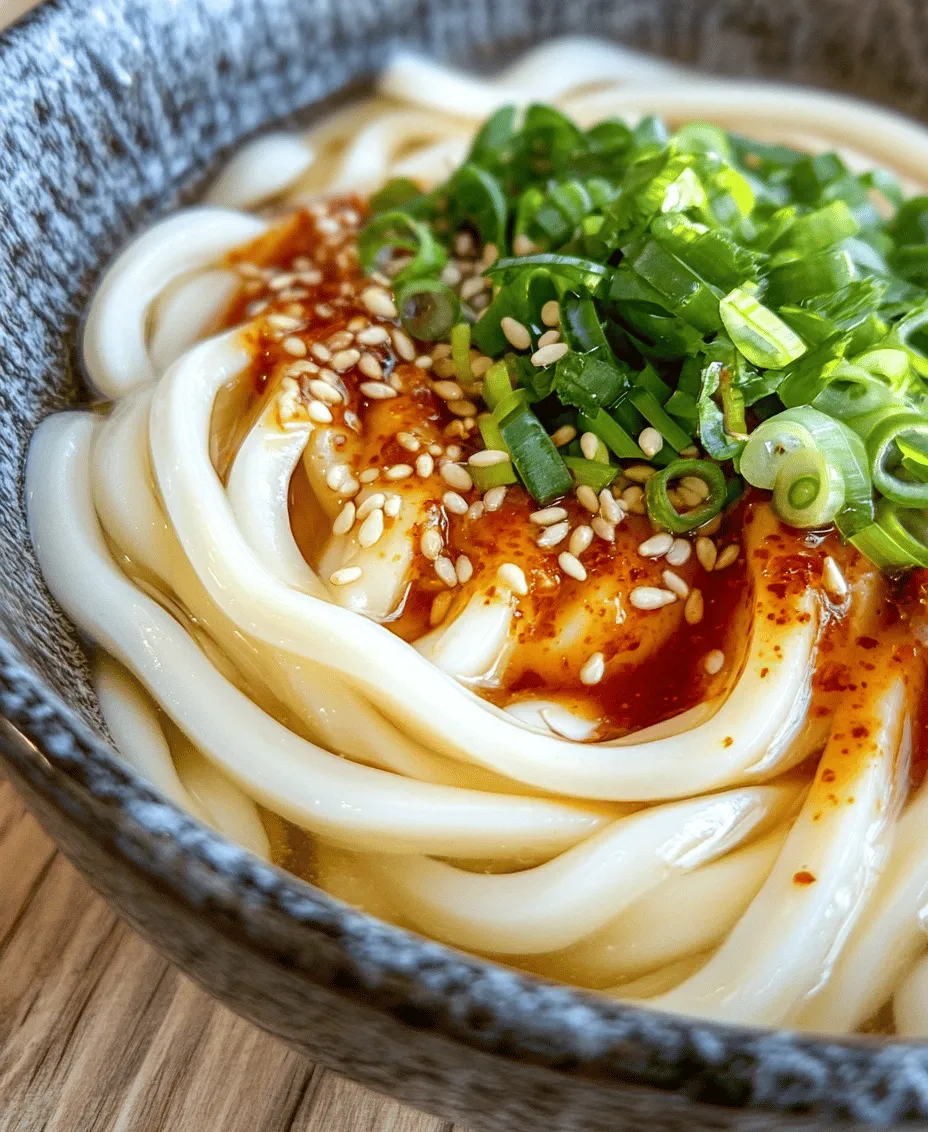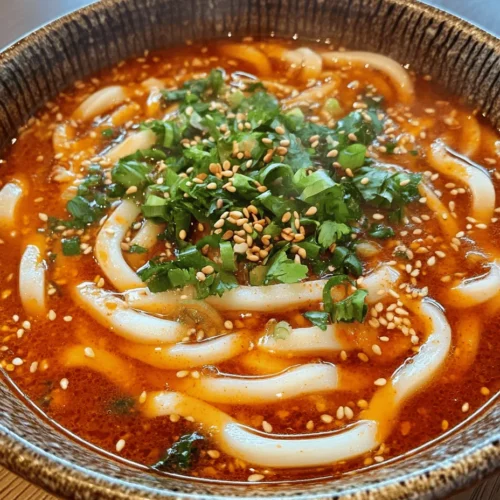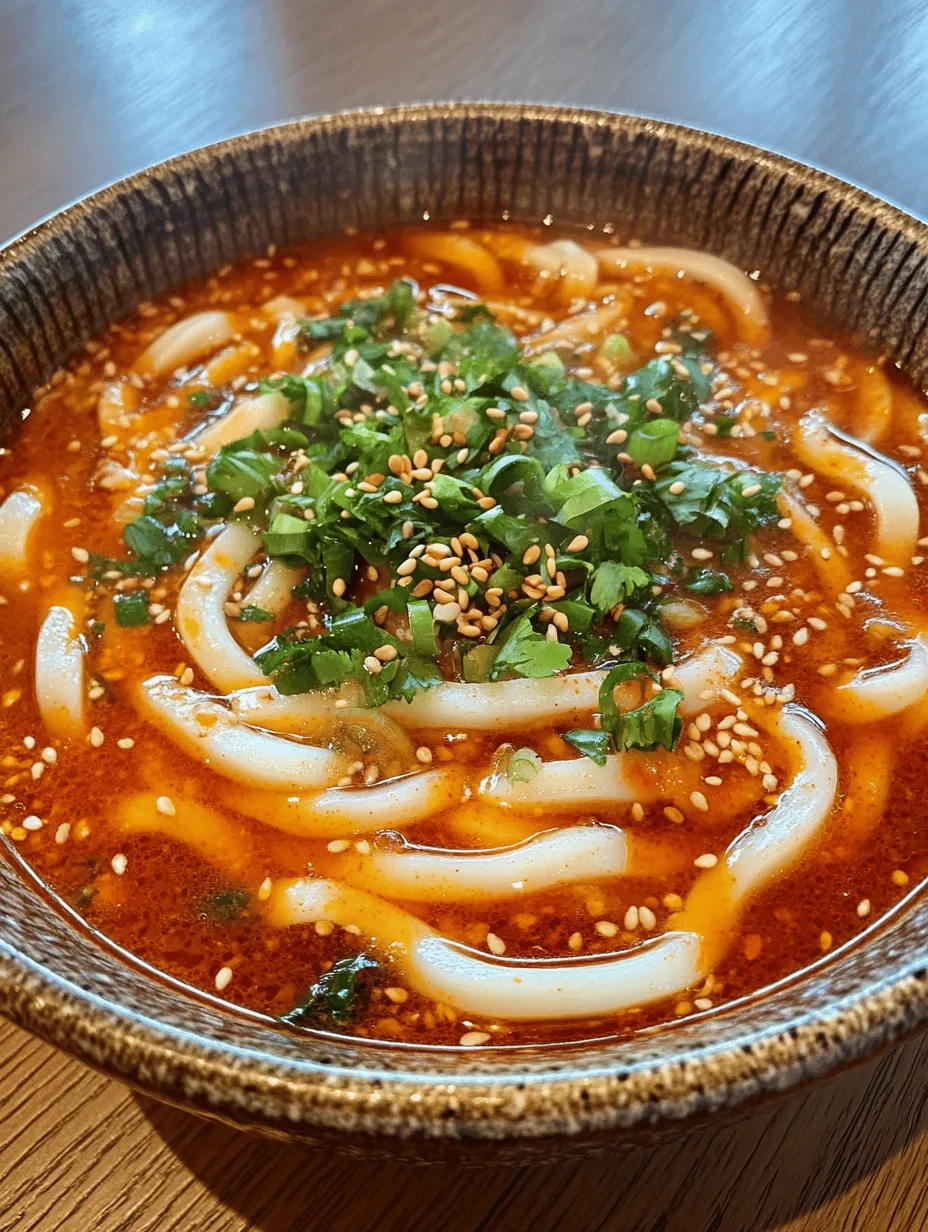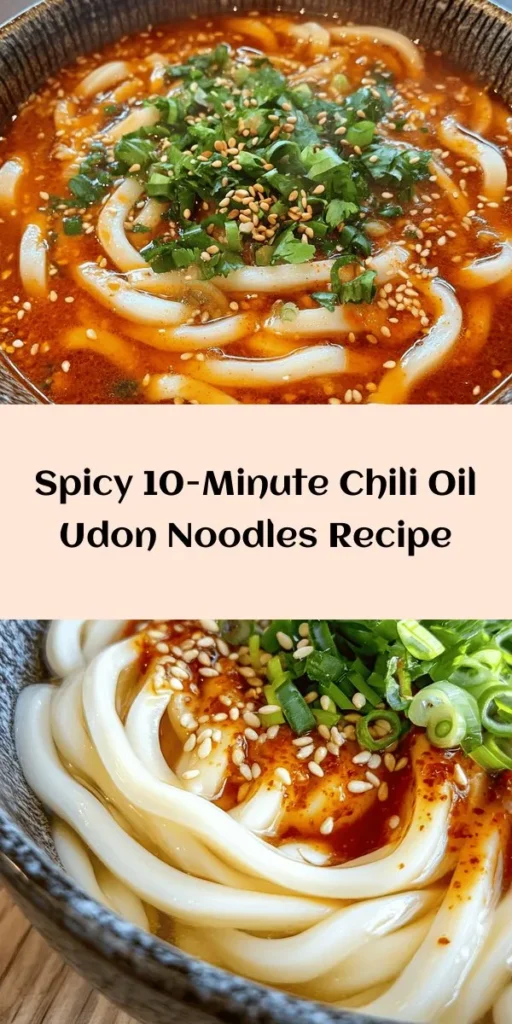In the bustling world of quick meals, 10-Minute Chili Oil Udon Noodles stand out as a flavorful and satisfying option. With a perfect blend of heat from chili oil, savory undertones from soy sauce, and the delightful chewiness of fresh udon noodles, this dish is not just a meal; it’s an experience. The simplicity of the preparation, combined with the rich flavors, makes it an ideal choice for busy weeknights or a quick lunch. Not only is this recipe easy to whip up in just ten minutes, but it also packs a punch in taste, ensuring that each bite is a burst of umami goodness.
Understanding Udon Noodles
Exploring Udon Noodles
What are Udon Noodles?
Udon noodles are thick, chewy wheat noodles that are a staple in Japanese cuisine. Traditionally made from just three basic ingredients—flour, water, and salt—these noodles are renowned for their smooth texture and ability to absorb flavors. Udon is incredibly versatile, often served in soup broths, stir-fried, or cold with dipping sauces. Their hearty nature makes them an excellent base for a variety of dishes, including our featured recipe, the Chili Oil Udon Noodles.
Nutritional Benefits of Udon Noodles
In addition to their delightful taste, udon noodles offer nutritional benefits. They are primarily composed of carbohydrates, making them a great source of energy. Whole wheat udon noodles, in particular, provide dietary fiber, which aids in digestion and promotes a feeling of fullness. Furthermore, udon noodles can be a good source of protein, especially when paired with vegetables or proteins like tofu, chicken, or seafood.
Different Types of Udon Noodles Available
Udon noodles come in various forms, each suited to different culinary applications. The most common types include:
– Fresh Udon: Soft and pliable, fresh udon noodles are preferred for their superior texture and taste. They are usually found in the refrigerated section of grocery stores.
– Frozen Udon: A convenient alternative, frozen udon retains much of the texture and flavor of fresh noodles. They are quick to prepare and require minimal cooking time.
– Dried Udon: These noodles have a longer shelf life and are more widely available. However, they require a longer cooking time to achieve the desired chewy consistency.
The Role of Udon in Japanese Cuisine
Historical Context of Udon in Japan
Udon has a long and storied history in Japan, dating back to at least the 9th century. Originally introduced through cultural exchanges with China, udon quickly became integrated into Japanese culinary traditions. Over the centuries, various regions of Japan have developed their unique styles of udon, leading to a rich tapestry of flavors and preparations. From the hot, comforting bowls of kake udon served in a savory broth to the cold zaru udon enjoyed in summer, udon’s adaptability has cemented its place in Japanese culture.
Traditional Dishes Featuring Udon
Udon is featured in a variety of traditional dishes that showcase its versatility. Some popular preparations include:
– Kake Udon: A simple dish where udon noodles are served in a hot broth made from dashi, soy sauce, and mirin, often garnished with scallions.
– Yaki Udon: Stir-fried udon with a medley of vegetables, meat, and a savory sauce, perfect for a quick and hearty meal.
– Curry Udon: This comforting dish features udon noodles served in a rich and spicy Japanese curry sauce, often accompanied by vegetables and protein.
The Essence of Chili Oil
What is Chili Oil?
Chili oil is a flavorful condiment made by infusing oil with chili peppers and other aromatics. The base oil can vary, but commonly used oils include vegetable oil and sesame oil, which contribute their unique flavors to the final product. Chili oil can range from mildly spicy to intensely fiery, depending on the type of peppers used and the quantity.
Ingredients Commonly Found in Chili Oil
The essential ingredients of chili oil typically include:
– Chili Peppers: Whole dried chilies or chili flakes are the primary source of heat and flavor.
– Oil: The oil serves as the base, helping to extract flavors from the chili and distribute them evenly.
– Aromatics: Garlic, ginger, and scallions are often added for depth and complexity.
– Seasonings: Ingredients like salt, sugar, and Sichuan peppercorns can enhance the flavor profile.
Variations of Chili Oil Around the World
Chili oil is not only popular in Japanese cuisine but is also a staple in many culinary traditions worldwide. For instance:
– Chinese Chili Oil: Often includes Sichuan peppercorns for a unique numbing effect, along with garlic and ginger.
– Korean Gochugaru Oil: Made with Korean red pepper flakes, this oil is known for its vibrant color and moderate heat, often used in Korean dishes.
– Thai Chili Oil: Incorporates ingredients like fish sauce and lime for a tangy, spicy kick.
Health Benefits of Chili Oil
Chili oil is not just a flavor enhancer; it also boasts several health benefits.
Antioxidants and Anti-inflammatory Properties
Chili oil contains capsaicin, the compound responsible for the heat in chili peppers. Capsaicin is known for its antioxidant properties, helping to combat oxidative stress in the body. Additionally, it has anti-inflammatory effects that may aid in reducing pain and discomfort.
How Chili Oil Can Enhance Flavor Without Extra Calories
One of the most appealing aspects of chili oil is its ability to add bold flavors without significantly increasing caloric intake. A small drizzle can transform a bland dish into a flavorful experience, making it a great addition for those looking to spice up their meals without adding excess calories.
Ingredient Breakdown for 10-Minute Chili Oil Udon Noodles
Fresh Udon Noodles
When preparing 10-Minute Chili Oil Udon Noodles, the choice of noodles is crucial for achieving the perfect texture and flavor.
Why Fresh Noodles Are Preferred
Fresh udon noodles are preferred due to their tender yet chewy consistency, which complements the rich flavors of the chili oil and other ingredients. Fresh noodles also cook quickly, making them ideal for a speedy meal. They tend to absorb flavors better than dried noodles, enhancing the overall taste of the dish.
Tips on Selecting Quality Udon Noodles
When shopping for udon noodles, consider the following tips to ensure you select the best quality:
– Check for Freshness: Look for noodles that are refrigerated and have a short shelf life. Fresh noodles should be soft and pliable.
– Texture Matters: Opt for noodles that feel smooth and have a consistent thickness. Avoid those with rough or uneven surfaces.
– Brand Reputation: Choose brands known for high-quality udon noodles. Some popular brands include Yamachan and Sun Noodle.
Chili Oil and Its Variants
Chili oil is the star ingredient in this recipe, providing the essential heat and flavor.
Homemade vs. Store-bought Chili Oil
While store-bought chili oil is convenient, making your own allows for customization. Homemade chili oil can be tailored to your preferred level of spice and flavor intensity. To make your own, simply heat oil and infuse it with your choice of dried chilies and aromatics.
Suggested Brands for Chili Oil
If you prefer to purchase chili oil, several brands offer excellent options. Some recommended brands include:
– Chili Crisp by Fly By Jing: This popular brand features crunchy garlic and onion, adding texture and depth.
– Szechuan Chili Oil by Lao Gan Ma: Known for its unique taste, this oil combines chili with fermented soybeans for added flavor.
– Chili Oil by Kadoya: A simple yet effective option, Kadoya’s chili oil is versatile and flavorful.
Essential Flavor Enhancers
To elevate the taste of the 10-Minute Chili Oil Udon Noodles, a few essential flavor enhancers play a vital role.
The Importance of Garlic
Garlic is a key ingredient that adds depth and aroma to the dish. It not only boosts flavor but also offers health benefits, including immune support and anti-inflammatory properties. Freshly minced garlic is recommended for the best flavor, as it releases aromatic oils that enhance the overall dish.
The Role of Soy Sauce and Rice Vinegar
Soy sauce is a staple in many Asian dishes and provides a salty, umami flavor that complements the heat of the chili oil. Opt for a quality soy sauce to enhance the dish’s overall taste.
Rice vinegar adds a tangy brightness, balancing the richness of the udon noodles and the oil. It rounds out the flavor profile, making the dish more complex and enjoyable.
Now that we’ve explored the background of udon noodles, the essence of chili oil, and the essential ingredients for this quick yet delicious dish, let’s dive into the detailed instructions for preparing 10-Minute Chili Oil Udon Noodles.

How Sesame Oil and Sugar Balance Flavors
Sesame oil and sugar play crucial roles in achieving the perfect balance of flavors in your 10-Minute Chili Oil Udon Noodles. The nutty, rich flavor of sesame oil complements the heat from the chili oil beautifully, while also imparting a depth that enhances the overall taste of the dish. When you add sugar to the mix, it serves as a counterbalance to the spiciness of the chili oil, creating a harmonious blend that excites the palate. This sweet-savory combination is integral to many Asian dishes, and in the case of udon noodles, it elevates the flavor profile, making each bite a delightful experience.
Garnishes and Optional Additions
The Significance of Green Onions and Sesame Seeds
Green onions and sesame seeds not only add visual appeal to your dish but also contribute significant flavor and texture. Green onions offer a fresh, mild onion flavor that brightens the dish, while sesame seeds provide a subtle crunch. To prepare them, simply slice the green onions thinly and toast the sesame seeds lightly in a dry pan until golden and fragrant. Sprinkle these garnishes generously over your finished udon noodles for a pop of color and flavor.
Exploring Protein Options: Tofu, Chicken, or Shrimp
Adding protein to your 10-Minute Chili Oil Udon Noodles transforms this dish into a satisfying meal. For a vegetarian option, consider cubed tofu, which absorbs the flavors of the sauce beautifully and adds a delightful texture. If you prefer meat, thinly sliced chicken or shrimp are fantastic choices. Both proteins cook quickly, making them perfect for this speedy dish. If using chicken, ensure it’s cooked through before adding it to the noodles for the best results.
The Role of Fresh Cilantro in Enhancing the Dish
Fresh cilantro is an excellent herb to finish off your udon noodles. Its bright, slightly citrusy flavor cuts through the richness of the sauce and adds a refreshing element to the dish. For maximum impact, chop the cilantro finely and sprinkle it on just before serving. This not only enhances the flavor but also adds a touch of color that makes your dish visually appealing.
Step-by-Step Guide to Preparing 10-Minute Chili Oil Udon Noodles
Boiling the Udon: A Crucial Step
Techniques for Perfect Udon Noodles
Start by bringing a large pot of water to a rolling boil. Add a generous pinch of salt to the water; this not only flavors the noodles but also helps maintain their texture. Once the water is boiling, add the udon noodles and stir gently to prevent them from sticking together. Boil the noodles according to package instructions, usually around 3-5 minutes, until they’re tender yet firm to the bite.
Tips for Rinsing and Cooling
After boiling, immediately drain the noodles in a colander and rinse them under cold water. This step is essential as it stops the cooking process and helps remove excess starch, preventing the noodles from becoming gummy. Rinsing also cools the noodles quickly, allowing you to integrate them into the dish without further cooking.
Crafting the Perfect Sauce
Mixing Ratios to Achieve the Desired Flavor
For the chili oil sauce, the balance of flavors is critical. In a mixing bowl, combine soy sauce, sesame oil, and chili oil. A recommended starting point is 2 tablespoons of soy sauce, 1 tablespoon of sesame oil, and 1 tablespoon of chili oil. Adjust the amounts based on your heat preference and taste. If you enjoy a spicier kick, you can increase the chili oil gradually.
The Importance of Dissolving Sugar in the Sauce
Add 1 teaspoon of sugar to the sauce mixture. It’s vital to dissolve the sugar completely to ensure a smooth sauce. You can do this by whisking the mixture vigorously until the sugar is fully incorporated. This step is crucial as undissolved sugar can create a gritty texture in the sauce, detracting from the overall eating experience.
Combining Ingredients: The Mixing Process
Proper Technique for Tossing the Noodles with Sauce
Once your sauce is ready, it’s time to combine it with the noodles. In a large mixing bowl, add the cooled udon noodles and pour the prepared sauce over them. Use tongs or chopsticks to gently toss the noodles in the sauce, ensuring that each strand is coated evenly. Be gentle during this process to avoid breaking the noodles.
How to Incorporate Proteins Without Breaking the Noodles
If you’ve decided to add protein, now is the time. Gently fold in your cooked protein of choice, whether it’s tofu, chicken, or shrimp. Use a spatula to lift and toss the noodles, taking care not to break them apart. The goal is to create a cohesive dish where the protein and noodles are well combined without compromising the integrity of the udon.
Final Touches Before Serving
Presentation Tips for a Visually Appealing Dish
Presentation is key when serving your udon noodles. Transfer the noodles to a large serving bowl or individual plates. To make the dish visually appealing, arrange the noodles in a mound and top them with the garnishes—sliced green onions, toasted sesame seeds, and chopped fresh cilantro. This not only adds color but also showcases the various textures and flavors of your dish.
Suggestions for Adapting the Dish Based on Personal Preferences
Feel free to customize your 10-Minute Chili Oil Udon Noodles based on what you have on hand or your specific tastes. You can add vegetables such as bok choy, bell peppers, or carrots for extra nutrition and flavor. If you prefer a creamier sauce, consider adding a splash of coconut milk or a dollop of peanut butter for a unique twist. The versatility of udon noodles means you can adapt this recipe to suit your pantry and palate.
Serving Suggestions and Pairings
Ideal Accompaniments for Udon Noodles
To elevate your meal, consider pairing your 10-Minute Chili Oil Udon Noodles with complementary beverages and side dishes. A chilled Asian lager or a light, crisp white wine such as Sauvignon Blanc can enhance the flavors of the dish without overpowering them. For a non-alcoholic option, green tea or a refreshing cucumber-infused water makes a delightful accompaniment.
Recommended Beverages That Complement the Dish
When selecting beverages, think about balancing the spice of the noodles. A slightly sweet drink, such as iced jasmine tea, can counteract the heat and offer a refreshing contrast. Additionally, traditional Japanese drinks like sake or shochu can provide an authentically Japanese dining experience.
Side Dishes That Pair Well With Udon Noodles
For side dishes, consider serving edamame, pickled vegetables, or a light seaweed salad. These options provide a nice contrast to the rich, spicy noodles, and add a variety of textures and flavors to your meal. Each side dish can help round out your dining experience, making it not just a meal but a delightful occasion.
Cultural Significance of Serving Udon
Traditional Japanese Dining Etiquette
In Japanese culture, dining etiquette plays a significant role in the enjoyment of food. It’s customary to eat udon noodles while slurping, as this is believed to enhance the flavor and show appreciation for the meal. When serving your 10-Minute Chili Oil Udon Noodles, consider incorporating this practice into your dining experience for a touch of authenticity.
How to Make the Dish Feel Authentic
To give your dish an authentic feel, serve it in traditional Japanese tableware. A simple, rustic bowl for the noodles and chopsticks will enhance the presentation and elevate the dining experience. Additionally, consider playing some soft Japanese music in the background to set the mood and create an inviting atmosphere.
Conclusion
10-Minute Chili Oil Udon Noodles represent a delightful fusion of simplicity and flavor, making them a perfect meal for busy individuals seeking a quick yet delicious option. With its rich history, easy preparation, and versatile ingredients, this dish is not only a staple in Japanese cuisine but also a welcome addition to any home cook’s repertoire. Whether enjoyed on a busy weeknight or as a comforting dish on a chilly day, these noodles are sure to impress with their bold flavors and comforting textures. Dive into this culinary adventure and savor the delicacies of udon noodles, enhanced by the vibrant flavors of chili oil and sesame. Enjoy your cooking journey!



